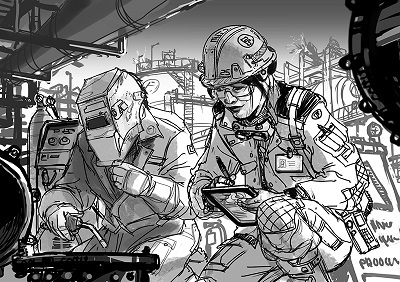Sketching the Future
This post is the fourth in a series about the IH Professional Pathway program. Read the previous posts, “Transforming Perceptions”, “Creating Character”, and “Finding Future-Forward Art.”
Vision? Check. Direction? Check. Concept? Check. Artist? Check.
With our key components in place, it was time to push forward on this burgeoning IH Professional Pathway idea.
I mentioned earlier that we did some extensive focus-group interviews with a variety of AIHA members. The seemingly random and odd questions I inserted into our question bank were about to pay off.
To properly showcase each “career stage,” we had to have scenes involving our avatars. Each scene had to be relevant and appropriate to the different career stages of development, but also be intriguing enough to catch the eye and showcase our future-forward concept.
To that end, we couldn't really show someone sitting at their desk, evaluating reports, or holding phone conversations. Fortunately, I had a wealth of stories from AIHA members that showed they were just as active in the field as they were in their offices.
I spent a couple of weeks going over the responses from the focus groups and came up with at least two scenes for each stage. After some discussion with other members of the Marketing and Communications team at AIHA, I then narrowed it down to one for each stage.
After writing out detailed descriptions of each scene—I had to “paint the picture” for our artist, after all—I submitted them to our then in-house Certified Industrial Hygienist, Mary Ann Latko. A few earnest discussions later, we had our first look at our project.
Here's what I had written down for our initial scene involving our early career professional:

Location is a refinery (oil or gas). Female, mid-twenties/early 30s, Asian features, shoulder-length (or longer) hair pulled into ponytail, braid, or bun. She is observing a welder, who is in the midst of construction work. (See dropbox for various photos of welders in action.) In order to have both subjects in close proximity, the welder should not be welding BUT it would be great to see some welding action being done in the background, at a distance. Possibly up higher, using a scaffold.
Female is dressed in a heavy workshirt, jeans, and work boots. She has safety glasses/goggles on (these can be “forward-future” looking) and is consulting a clipboard or tablet (possibly using a pen or stylus). She has a badge, possible lanyard/keycard, a belt accessory back (with small tools/sensors clipped or pocketed). The welder should have a welding mask (raised), tank, torch, possible cart (for a larger tank and fire extinguisher), heavy work shirt, jeans, boots, heavy oversized gloves. He could be kneeling or on one knee, bored, waiting for her assessment of his work. Welder can be any gender/ethnicity.
The immediate work area should be cordoned off in some fashion, either through caution tape, a flexible barricade, or possibly a ‘futuristic’ version of such (maybe with small flashing yellow caution lights?). A construction truck/vehicle (or part of one) could be seen as well, if desired. Try not to use smokestacks or other indications of pollution in the background, but making the area worn out, used, and grimy is fine.
Additional background people are fine, and should include hard hats and safety goggles/glasses.
Mary Ann consulted with a few CIHs and welding professionals and provided some great feedback, which we incorporated into our descriptions for the artist. He then turned back to me with some initial sketches.
Thanks to Mary Ann's help, I was able to pinpoint and provide our artist with real-world examples of equipment, procedures, and gear. While he wouldn't be using the examples directly, they did help him achieve the future-forward visualization that we wanted while still retaining some accuracy as to the common tools and resources used by IHs worldwide.
Interestingly, after we submitted the descriptions, references, and notes to the artist, we realized that our first four avatars might not fully encompass the breadth of our membership’s diversity. Adding another four scenes would have broken our budget, so we instead contracted a fifth scene that captured the “flipside” version of each avatar. Each of our alternates would have similar gear, clothing, theme, and other identifiers. (And later, the same letter to their first name.) These four would make up our fifth and final scene for this phase. They would also give us alternate biographical images, so we could double up our avatar count for minimal cost.

Our artist Klaus added the fifth scene to the project, and soon after we had our first look at the future of IH professionals.

Comments
There are no submissions.